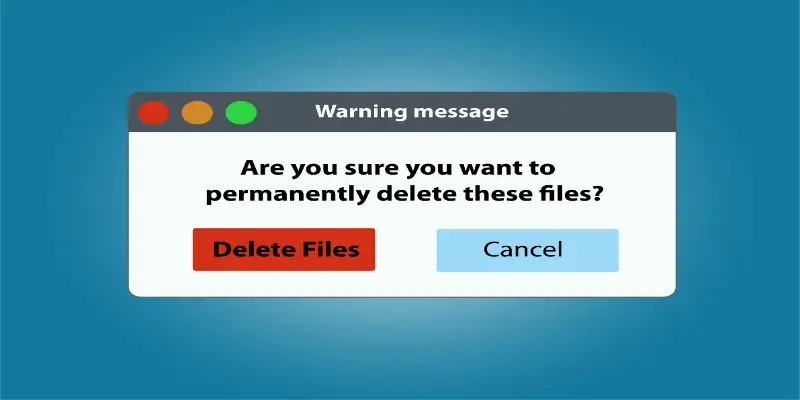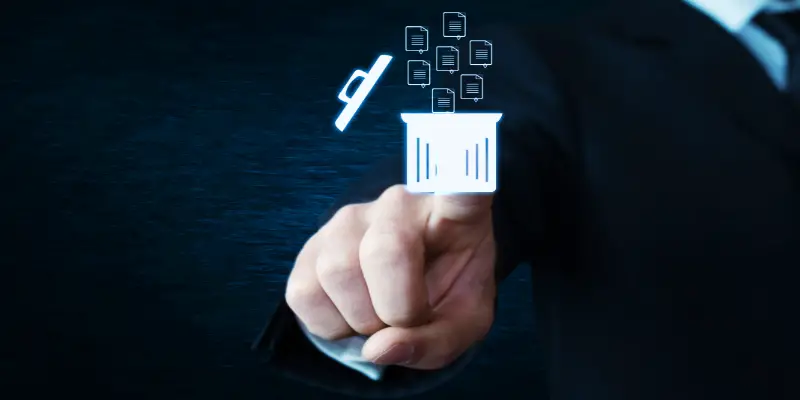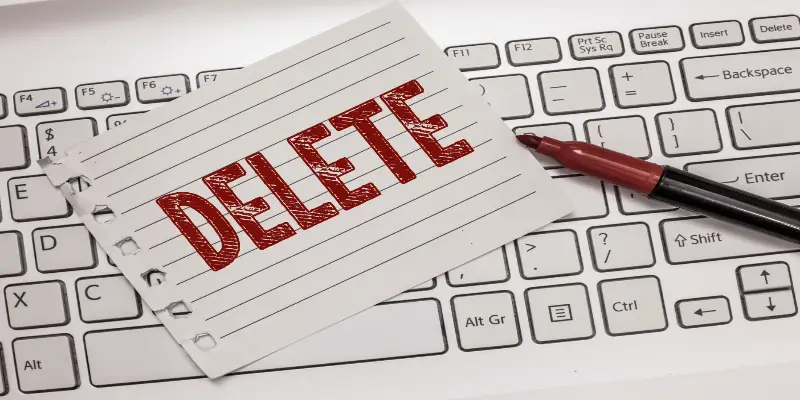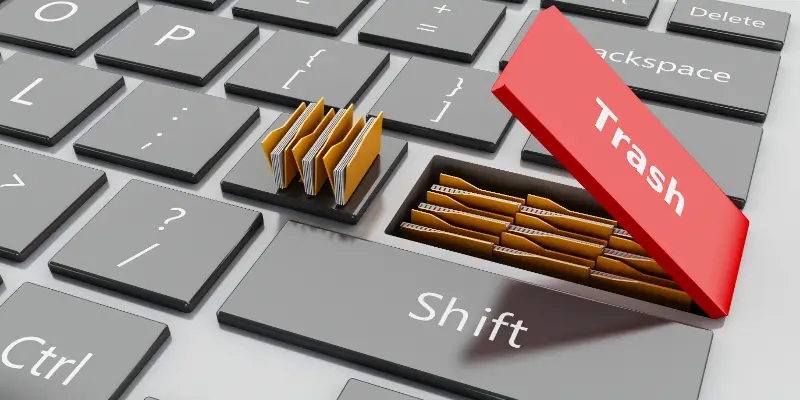Disclaimer: This post may contain affiliate links, meaning we get a small commission if you make a purchase through our links, at no cost to you. For more information, please visit our Disclaimer Page.
When you delete a file from your computer, it’s not completely gone. The file may still exist on your hard drive even after you remove it from your recycle bin.
There are software solutions for completely deleting files from your computer. However, you can overwrite the file with ones and zeros or use a shredding tool to permanently delete the file. Some programs wipe out the entire drive while others delete only the selected files and folders.
If you don’t completely erase deleted files, anyone can recover them. Complete deletion is important especially where it concerns sensitive personal information and financial documents.
Table of Contents
What Happens When You Delete a File?
Windows Operating Systems and other operating systems use pointers to track your computer files. There is a tracker for every file, folder, and byte of data you create on your computer.
Whenever you delete any file, what you’ve essentially done is delete the tracker pointing to the file. You haven’t deleted the file itself. So the data still exists in a sector of your hard drive, even though the system shows the data no longer exists.
The reason the OS only deletes the pointer is because it takes much longer to delete a file than it takes to delete the pointer. Thus, for fast operations, the OS will only delete the pointer and then later overwrite the deleted data with new information.
As you continue creating new files and folders, the OS overwrites the sections of the hard drive that have no pointers that indicate the existence of data.
Until your OS overwrites the hard drive sector, a file recovery program can scan, find, and restore the deleted files. However, this only applies to regular Hard Disk Drives (HDD). For Solid-State Drives (SSD), the data is removed permanently when you delete files and folders.
To understand how deleting data works, let’s first understand how data storage works in a computer.
How Does Data Storage Work In The Computer?
Your hard disk writes every byte of information you create as a series of blocks represented by 1’s and 0’s. These bits of data are written in long continuous bands and saved around the physical hard drive. In SSD and USB drives, the bytes are stored in a series of individual memory cells rather than long bands.
For speed and efficiency, the computer writes the data in the first available space it can find that’s sizable enough to hold the file. If the file is too big for one section, the computer may break the file into multiple sections.
The saved file is then written on another section called the File Allocation Table (FAT). It’s the FAT that tells your computer system where the file is located on the drive. FAT organizes all data bits in an orderly fashion. FAT also protects written data so the computer can’t write over used space.
When you delete a folder or a file and remove it from the recycle bin, all what you’ve done is instruct the FAT to remove pointers to the data. FAT allocates that space as free space, ready to be written over.
Thus, instead of the computer going and erasing all the 1’s and 0’s, it waits until there’s something new to store. Then it stores a new series of 1.s and 0’s over the old one.
How to Permanently Delete Files from the Computer?
If you want to delete your files permanently, you’ll want to make sure no software can recover the data. No matter what type of computer or operating system you’re using, your first step is to press delete on the file. After that, remove the file from the Recycle Bin (Windows) or the Trash folder (macOS).
Now that you’ve removed the pointers to the file, take one of the following steps to ensure permanent and irrevocable removal.
Fill HDD with Gibberish
The simplest way to permanently remove deleted files is to overwrite that space with new data. This method formats a drive rather than acting on such one file or folder.
Actually most of the data erasing software in the market work by overwriting the data with gibberish. Just that the software automates and speeds up the process.
To write zeros to your hard drive, you can use the command prompt to format your drive.
- Go to the search button on your taskbar and type “cmd” to bring up the command prompt.
- Select “Run as administrator”
- Type format d:/fs:NTFS/p:1 and press enter. This will format your D drive using the NTFS file system that most computers use. This command writes zeros to all sectors of the chosen drive.
- You can change the drive letter. You can also change the format type from NTFS to any other, e.g. FAT32. You may also change p:1 to p:2 for the overwrite to perform two passes instead of one. Though one pass is usually enough to prevent hackers and specialists from recovering your deleted files.
- The cmd will ask whether you want to proceed with format, press y for yes.
- Wait until the format process is complete.
- Don’t interrupt the process. Wait until the screen displays “creating file system structures”.
- You can repeat these steps for any other partitions you want to format.
- Once done, type ‘exit’ then press enter to exit the Command Prompt.
Gutmann Method
One or two passes of overwriting data with ones and zeros is good enough for personal use. However, if you’re dealing with highly classified or very sensitive information, there’s software that can still recover your deleted files. The Gutmann method states that you have to complete 35 passes for a complete data sanitization process.
With the Gutmann method, you don’t just overwrite our sensitive files with zeros and ones. You employ more random characters that make it harder, if not impossible, to recover your deleted data.
The Gutmann method was first introduced by Peter Gutmann in 1996. It’s important to note that back then, Gutmann was concerned with older drives where data could be recovered by using Magnetic Force Microscopy (MFM). Nonetheless, data security experts still consider this one of the top ways to ensure complete data sanitization.
In the Gutmann method, you start with four random write patterns. In each pattern, you overwrite your hard disk with random binary notation and random hex notation.
You then follow up with 28 patterns of specific binary notations and specific hex notations. You finish the process by executing four random patterns of binary and hex notations.
Today, most data security experts agree that the Gutmann method is unnecessary for modern encoding methods. For modern drives, a three-pass overwrite should be more than sufficient.
iSumsoft FileZero
When you have confidential business documents, sensitive financial data, or even scandalous photos you want to get rid of then an effective deleting software might be your best bet.
iSumsoft FileZero is a special file-deleting software that works to shred your files and permanently delete them from your hard drive. The advantage of using such file-shredding software is you don’t have to format your whole drive. You only delete the sensitive files and everything else remains unaffected.
Here’s how to use iSumsoft FileZero:
- Install and launch the iSumsoft FileZero software. You can download the software online.
- Choose the files and folders you wish to delete from your system. To choose files and folders, click on ‘Add’ in the software’s dialogue box.
- Once you have selected the files, click ‘OK’.
- All your selected files will show up in a list. Double-check that you have picked the correct files.
- If you change your mind about deleting a particular file, or you find that you added it by mistake, highlight the file and click the ‘Remove’ button.
- Once you’ve confirmed your list, choose the ‘Slow mode (recommended)’ option. In slow mode, the software will complete multiple passes to ensure absolute sanitization. Meaning the data will be shredded more times.
- You can choose ‘Fast Mode’ if you feel your data doesn’t warrant too much effort. Sometimes too many overwrites can cause your hard disk to start lagging in performance.
- Wait for the software to completely delete all your chosen files. At 100%, your files are completely and irrecoverably deleted from your system.
DBAN
DBAN is a premium-rate software for permanently deleting files. It can be used for deleting files from your computer, server, virtual machines, and mobile devices.
DBAN works best for personal use rather than enterprise use. So don’t use it if you’re wiping company computers where data auditing or regulatory compliance is strict.
To use DBAN:
- First start by creating a bootable CD or a bootable USB drive.
- Back up important data.
- Download DBAN from their official website.
- Burn the software into a CD. Make sure you unpack the contents otherwise the software won’t work.
- On your computer, unplug any storage devices that you don’t want to erase. These may include hard drives, external HDD, SD cards, and USB memory sticks. Though DBAN selects the drives to wipe, you don’t want any accidental erasures.
- Restart your computer by booting from the bootable CD or USB flash drive.
- Once you reboot from disk, select ‘Press the ENTER key to start DBAN in interactive mode.’
- Select the drive you want to permanently erase.
- Start the wipe process and wait till completion.
- Restart your computer. The drive should be wiped clean.
Eraser
If you’re looking for a free, effective, and secure method of erasing your files, Eraser can be a great option for you. Eraser can permanently delete individual files, multiple folders, a drive partition, or the entire hard disk drive.
You can also automate the deletion process by manually setting up various tasks to run each time you start Windows. You may even schedule the tasks to run at a particular time each day. To use the program:
- Download the freeware from the Eraser website.
- Install the program.
- Open the program and go to settings.
- Enable the option to integrate Eraser into Windows Explorer.
- Open Explorer and right-click to select the file or folder you want to delete.
- On the pop up window, select the Eraser command and confirm you want to erase the file.
- Click ‘Yes’ and your selected file will delete permanently.
- To schedule a task, click on ‘Erase Schedule’ and select the option ‘New Task’.
- In the task window, name your task with an easy to remember identifier.
- Click the ‘Add’ button then select all files and folders you want to permanently delete.
- On the drop-down menu, go to ‘Eraser Method’ and select your preferred erasing standard, then click ‘OK’.
- Select your schedule. The task will run at the appointed time.
File Shredder
Another efficient and secure file-shredding program is the File Shredder. As the name suggests, the software can permanently delete your files, folders, partitions, and hard disk. The program can also shred your free disk space, ensuring a clean sweep.
To use File Shredder:
- Download the program from their website and install it to your computer.
- Open File Shredder program and select options to either ‘Add File’ or ‘Add Folder’.
- Add single or multiple files and/or folders.
- Review your choices to make sure you really want to permanently delete them.
- Click ‘Shred Files Now’. That’s it.
- Alternatively, you can open your File Explorer and right-click on your chosen files and folders.
- You may Shift + Right-Click or Ctrl + Right-Click to select multiple files and folders at once.
- On the pop up menu, hover on File Shredder and select “Secure Delete Files’.
Recuva
Recuva is mostly known as a file recovery tool. When you delete files from your hard drive and follow up with removing from the recycle bin, Recuva can still recover the deleted files.
What most people don’t realize is that Recuva also functions as a program for erasing files permanently. Recuva also works to clear your junk, speed up your PC, and protect your data privacy. To securely and permanently delete files with Recuva:
- Download the software from their website.
- Launch Recuva and run the program in either Advanced or Wizard mode.
- In the window that appears, select the files you want to permanently delete.
- Double-check the list of chosen files. Once you confirm, select ‘Secure Overwrite Checked’.
- Confirm the deletion by clicking ‘Yes’.
EaseUS Partition Master
If you’re looking to sell your computer or simply want a fresh start for your computer, you can erase all your disk data permanently with EaseUS Partition Master. The software program works well with Windows 10, 8, and 7.
- EaseUS Partition Master offers several drive management solutions including:
- Transferring free disk space from one partition to another.
- Resizing partitions, merging partitions, and creating or deleting partitions.
- Clone disk or partition.
- Check the file system.
- Convert to Master Boot Record (MBR), Guid Partition Table (GUID), dynamic or basic, or FAT32 to NTFS.
- To wipe your data:
- Download and Install EaseUS Partition Master.
- Open the program and select the HDD or SSD you want to erase.
- Select the number of times you want to wipe your data. Maximum is ten times.
- Click ‘OK’.
- A pop up message will appear telling you “A computer restart after disk erase is recommended”. Click ‘OK’.
- Select ‘Execute Operations’ and click ‘Apply’.
- You can wipe your hard drive multiple times. 2 or three sweeps should be enough to ensure your data can’t be recovered.
How Do You Delete Something That Won’t Delete?
Sometimes you may want to delete a file but the system won’t allow you to delete. This often happens because your OS marks the file as in use by another program or it’s write-protected. Therefore, you can’t delete, move, or rename the file.
To remove the file you have to force delete. Here’s how:
- Open the start menu.
- Type ‘run’.
- Enter and input cmd then enter again to open the command prompt.
- Once the command prompt is open, type del /f filename (filename is the name of the file you want to delete.
- Hit Enter and the file is deleted.
How to Permanently Delete Files from Hard Drive, USB, SD Card?
We have explored different ways to permanently delete files from the hard disk. Permanently deleting from a USB memory drive or an SD card works the same.
To delete from either a USB flash drive or SD card:
- Insert your USB drive into your PC’s USB port. If it’s an SD card, insert into the SD memory slot of your computer.
- In File Explorer, double-click on the Removable Disk (USB or SD) where the file is located.
- Right-click on the chosen file and select ‘Delete’.
- Click ‘Yes’ to confirm that you want to permanently delete the file.
- You can also use the above-mentioned file-shredding tools to ensure the file is permanently deleted.
How to Permanently Delete Files From SSD
Some of the methods that apply to permanent deletion of files in HDD drives don’t apply to deleting from Solid-State Drives (SSD). All modern SSD drives are TRIM-enabled.
TRIM allows your OS to tell your SSD which data blocks are marked for deletion. The system then works to wipe the data internally, no third-party software required. In this way, TRIM allows your OS to operate more efficiently and load faster. Even more important, your drive has a longer lifespan.
To find out whether your SSD is TRIM-enabled on your macOS:
- Click on the Apple icon and go to ‘About This Mac’.
- Select ‘System Report’.
- Under ‘Hardware’ select ‘SATA/SATA Express’.
- Scroll down then select ‘TRIM Support’.
- If it’s marked ‘YES’ then TRIM is enabled. If ‘No’ then it’s disabled.
- If disabled, log into your Mac as an administrator.
- Run ‘Terminal’.
- Type the command ‘sudo trimforce enable’ and press enter.
- Type in your account password when prompted.
- When the system asks for confirmation, type ‘y’ and press enter.
- Your computer will ask to reboot. Type ‘y’ and press enter once more.
- On restart, your system will be TRIM-enabled.
Where Do Permanently Deleted Files Go In Computers?
When you delete files from your computer they normally go to the recycle bin. From the recycle bin, you can then ‘permanently delete’ the file. However, the files haven’t really been deleted from the hard drive.
The files are now stored in the depths of your hard drive but the system has marked the space the files occupy as ready to overwrite. The system marks these files as inaccessible. While you can’t see these files from File Explorer, they can still be recovered using your OS recovery features or by using special software.
For instance, here is a guide to recover deleted files in Windows 10.
- Open the folder where the file was located before you send it to the recycle bin.
- Right click and on the pop up menu click on ‘History’.
- Click ‘Previous’.
- Select the file you want to recover and left-click to ‘Restore’.
However, for this to work you have to act immediately. Otherwise the system will overwrite the deleted file with new data.
Conclusion
Over time and with usage, your computer collects and stores lots of personal information. These include sensitive files, financial information, license keys, personal photos, medical records, tax returns, and other data you would rather not land in someone else’s hands. A simple delete and clearing your recycle bin may not securely or permanently delete the residual data.
The above guide offers different ways and tools to permanently delete unwanted or sensitive files. For extremely sensitive data and for hard drives you no longer want to use, you can consider smashing the drive into tiny pieces after using shredding software to wipe your drive.




